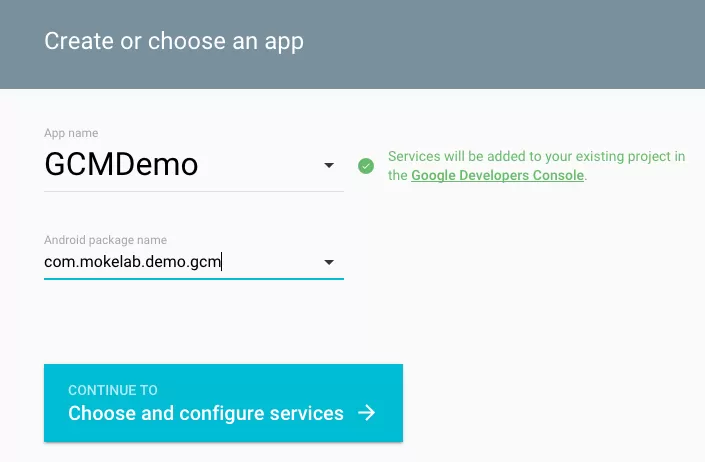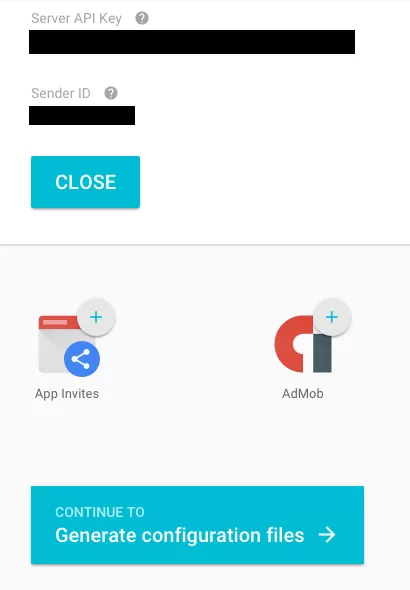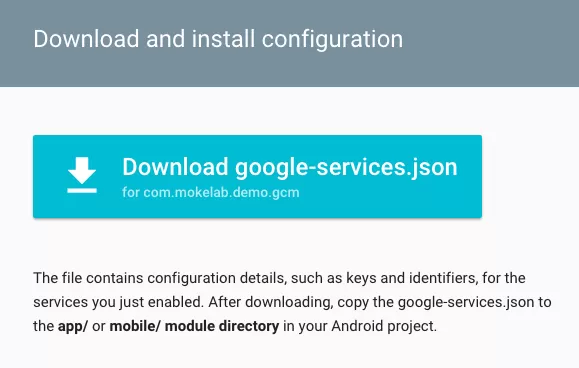Google Play Servicesを使ってアプリにGCMを導入する
最終更新日:2017-05-04
FCM
GCMは2016年のGoogle I/OでFCM(Firebase Cloud Messaging)に移行しました。本記事は残しますが、FCMへの移行をすすめましょう。
まずはアプリ側の実装をやりましょう。アプリにGCMを導入するには、次の8ステップを行います。
- Google Developer Consoleでプロジェクトを作成し、GCM for Androidを有効にする
- Google Developersで設定ファイル(jsonファイル)を取得する
- Android Studioでプロジェクトを作成し、jsonファイルを配置する
- build.gradleを編集し、Google Play Serviceを追加する
- AndroidManifest.xmlを編集し、permissionなどを追加する
- IntentServiceを追加し、その中でregistration tokenを取得する
- GcmListenerServiceを継承したクラスを追加し、その中でPush受信時の処理を記述する
- InstanceIDListenerServiceを継承したクラスを追加し、その中でregistration tokenが変更された時の処理を記述する
やや長いですが、1つずつみていきましょう。
Google Developer Consoleでプロジェクトを作成し、GCM for Androidを有効にする
(以前と同じなので後で書く)
Google Developersで設定ファイル(jsonファイル)を取得する
ここで設定ファイルを取得します。この時点でアプリのパッケージ名を決めておく必要があります。
まず、GET A CONFIGURATION FILEボタンをクリックします。
次に、先ほどGoogle Developer Consoleで作成したプロジェクトを選び、アプリのパッケージ名を入力します。
すると、Server API KeyやSender IDが表示されます。Server API Keyは後で使うので控えておきます。ここではGenerate configuration fileをクリックします。
クリックすると、Download google-services.jsonボタンが表示されるので、これをクリックしてjsonファイルをダウンロードします。
Android Studioでプロジェクトを作成し、jsonファイルを配置する
API Levelは10以上にしておきます。プロジェクトが作成されたら、先ほどダウンロードしたgoogle-services.jsonファイルをappフォルダ(Wear対応アプリの場合はmobileフォルダ)直下にいれます。
build.gradleを編集し、Google Play Serviceを追加する
google-services.jsonファイルはGradleプラグインで処理されるようなので、まず、トップレベルにあるbuild.graldeファイルにcom.google.gms:google-services:1.3.0を追加します。
buildscript {
repositories {
jcenter()
}
dependencies {
classpath 'com.android.tools.build:gradle:1.3.0'
// 次の行を追加
classpath 'com.google.gms:google-services:1.3.0'
// NOTE: Do not place your application dependencies here; they belong
// in the individual module build.gradle files
}
}
次に、app配下にあるbuild.gradleのdependenciesにcom.google.android.gms:play-services:7.8.0を追加します。
dependencies {
compile fileTree(dir: 'libs', include: ['*.jar'])
testCompile 'junit:junit:4.12'
compile 'com.android.support:appcompat-v7:22.2.1'
// 次の行を追加
compile 'com.google.android.gms:play-services:7.8.0'
}
AndroidManifest.xmlを編集し、permissionなどを追加する
いくつかpermissionを追加する必要があります。{package}の部分はアプリのパッケージ名で置き換えてください。
<manifest xmlns:android="http://schemas.android.com/apk/res/android"
package="{package}" >
<uses-permission android:name="android.permission.INTERNET" />
<uses-permission android:name="android.permission.WAKE_LOCK" />
<uses-permission android:name="com.google.android.c2dm.permission.RECEIVE" />
<permission android:name="{package}.permission.C2D_MESSAGE"
android:protectionLevel="signature" />
<uses-permission android:name="{package}.permission.C2D_MESSAGE" />
<application>
<receiver
android:name="com.google.android.gms.gcm.GcmReceiver"
android:exported="true"
android:permission="com.google.android.c2dm.permission.SEND" >
<intent-filter>
<action android:name="com.google.android.c2dm.intent.RECEIVE" />
<category android:name="{package}" />
</intent-filter>
<intent-filter>
<action android:name="com.google.android.c2dm.intent.REGISTRATION" />
<category android:name="{package}" />
</intent-filter>
</receiver>
</application>
</manifest>
IntentServiceを追加し、その中でregistration tokenを取得する
まずはトークン取得の処理をIntentService内に記述します。
public class RegistrationIntentService extends IntentService {
private static final String TAG = "Registration service";
/**
* Creates an IntentService. Invoked by your subclass's constructor.
*/
public RegistrationIntentService() {
super("Registration service");
}
@Override
protected void onHandleIntent(Intent intent) {
try {
InstanceID instanceID = InstanceID.getInstance(this);
String token = instanceID.getToken(getString(R.string.gcm_defaultSenderId),
GoogleCloudMessaging.INSTANCE_ID_SCOPE, null);
Log.v(TAG, "token=" + token);
// このトークンをPush送信用サーバーやKii Cloudなどのサービスに送信する
} catch (IOException e) {
Log.v(TAG, "IO Exception " + e.getMessage());
}
}
}
AndroidManifest.xmlにも追加します。
<manifest>
<application>
<service android:name=".RegistrationIntentService"/>
</application>
</manifest>
GcmListenerServiceを継承したクラスを追加し、その中でPush受信時の処理を記述する
Google Play Services 7.5以前ではBroadcastReceiverで受信していましたが、7.5以降ではGcmListenerServiceを継承したクラスで受信します(厳密にはライブラリで提供されるBroadcastReceiverで受信しているようですが)。
Pushメッセージを受信すると、onMessageReceived()が呼ばれます。第1引数にはSender IDが、第2引数にはメッセージ本体が渡されます。
public class MyGCMListenerservice extends GcmListenerService {
private static final String TAG = "GCMListener";
@Override
public void onMessageReceived(String from, Bundle data) {
super.onMessageReceived(from, data);
Log.v(TAG, "from=" + from);
Log.v(TAG, "data=" + data.toString());
}
}
AndroidManifest.xmlに次のエントリーを追加します。
<manifest>
<application>
<service
android:name=".MyGCMListenerservice"
android:exported="false" >
<intent-filter>
<action android:name="com.google.android.c2dm.intent.RECEIVE" />
</intent-filter>
</service>
</application>
</manifest>
InstanceIDListenerServiceを継承したクラスを追加し、その中でregistration tokenが変更された時の処理を記述する
registration tokenはGCMサーバーによって不定期に変更されます。Google Play Services 7.5以降では、変更されたことをアプリが検知することができるようになりました。InstanceIDListenerServiceを継承したクラスを追加し、変更された時の処理を記述します。
public class MyInstanceIDListenerService extends InstanceIDListenerService {
@Override
public void onTokenRefresh() {
super.onTokenRefresh();
}
}
AndroidManifest.xmlに次のエントリーを追加します。
<manifest>
<application>
<service
android:name=".MyInstanceIDListenerService"
android:exported="false">
<intent-filter>
<action android:name="com.google.android.gms.iid.InstanceID"/>
</intent-filter>
</service>
</application>
</manifest>
AndroidManifest.xmlの最終的な形
アプリのパッケージ名をcom.mokelab.demo.gcmとした場合、最終的にAndroidManifest.xmlは次のようになります。
<manifest xmlns:android="http://schemas.android.com/apk/res/android"
package="com.mokelab.demo.gcm" >
<uses-permission android:name="android.permission.INTERNET" />
<uses-permission android:name="android.permission.WAKE_LOCK" />
<uses-permission android:name="com.google.android.c2dm.permission.RECEIVE" />
<permission android:name="com.mokelab.demo.gcm.permission.C2D_MESSAGE"
android:protectionLevel="signature" />
<uses-permission android:name="com.mokelab.demo.gcm.permission.C2D_MESSAGE" />
<application
android:allowBackup="true"
android:icon="@mipmap/ic_launcher"
android:label="@string/app_name"
android:theme="@style/AppTheme" >
<activity
android:name=".MainActivity"
android:label="@string/app_name" >
<intent-filter>
<action android:name="android.intent.action.MAIN" />
<category android:name="android.intent.category.LAUNCHER" />
</intent-filter>
</activity>
<receiver
android:name="com.google.android.gms.gcm.GcmReceiver"
android:exported="true"
android:permission="com.google.android.c2dm.permission.SEND" >
<intent-filter>
<action android:name="com.google.android.c2dm.intent.RECEIVE" />
<category android:name="com.mokelab.demo.gcm" />
</intent-filter>
<intent-filter>
<action android:name="com.google.android.c2dm.intent.REGISTRATION" />
<category android:name="com.mokelab.demo.gcm" />
</intent-filter>
</receiver>
<service
android:name=".MyGCMListenerservice"
android:exported="false" >
<intent-filter>
<action android:name="com.google.android.c2dm.intent.RECEIVE" />
</intent-filter>
</service>
<service
android:name=".MyInstanceIDListenerService"
android:exported="false">
<intent-filter>
<action android:name="com.google.android.gms.iid.InstanceID"/>
</intent-filter>
</service>
<service android:name=".RegistrationIntentService"/>
</application>
</manifest>





